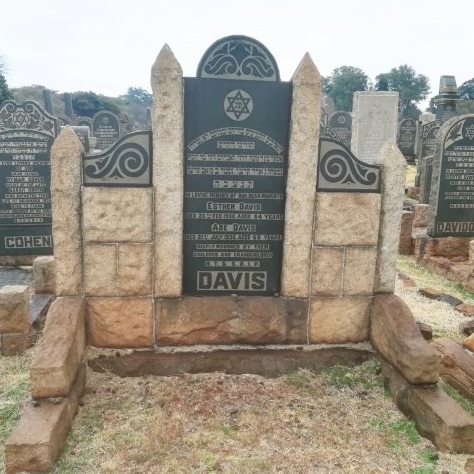click to dowload our latest edition
CLICK HERE TO SUBSCRIBE TO OUR NEWSLETTER


Published
6 years agoon
By
adminJORDAN MOSHE
Chaim Sadowsky, although poor and far less glamorous than Solarsh, visited patients at local hospitals every day of his life. Jew or gentile, he sat with them, kept them company and begged for their needs from wealthier people.
The enterprising Zelda Klass arrived from Lithuania without a penny to her name and took up selling root beer on the street to support her family.
What do these larger-than-life personalities all have in common? They are all interred in the Jewish Cemetery in Brixton. This suburb, the site of the landmark Sentech Tower, is located near Auckland Park and Melville. Once a multicultural creative hub, Brixton is today known for its crime, illicit drug trade and dilapidation. However, nestled at the far end of its decades-old cemetery is the final resting place of countless Jewish personalities, each with their own rich history and story to tell.
Johannesburg initially set land aside for burial from its date of origin in 1886, and its first cemetery was located close to the centre of town, on the corner of Bree and Harrison Streets. Within two years, Braamfontein cemetery was then established. As early as 1905, it was reported that “Braamfontein would be fully occupied within 20 months” and Brixton, located almost 1km west of Braamfontein Cemetery, became the Johannesburg’s principal cemetery in 1912.
This lasted until it reached capacity and was replaced by West Park Cemetery in 1942. However, Brixton includes many family plots, so people continued to be buried there even after West Park was opened.
Sadly, Brixton Cemetery shows neglect, decay and evidence of homeless people inhabiting the place. Fortunately, the exception to this is the Jewish section, which is maintained regularly by the Chevrah Kadisha. “The cemetery is a jumble of mess,” says Flo Bird, one of the directors of the Johannesburg Heritage Foundation. “However, the Jewish section is in much better condition than that of the goyim over the fence,” she jokes.
“The Chev makes sure to keep it in good shape and looks after the graves rather well.”
The first Jewish burial took place there in 1921, a practice which continued until the 1940s. Although its ohel was torn down in recent years, the cemetery remains open to visitors and offers a rich heritage to those wishing to delve into our community’s history. From business moguls to humble vendors, Torah giants to social activists, the spectrum of individuals buried in the grounds is certainly diverse.
A few rows away from Pamela Solarsh lies Nathan Kasrils, grandfather of former intelligence minister Ronnie Kasrils. Apart from being recognised as a prominent socialist, the older Kasrils was feted for his service in the Boer War by none other than General de la Rey himself. “He declared that Kasrils was both a good spy and an excellent sharpshooter,” says Bird.
Several other men – many of them young – are similarly remembered on their tombstones for their contributions to war efforts: Zalman Datt, a young air force flying tutor, tragically lost his life in a training exercise while helping pilots prepare for battle in 1941.
The cemetery also hosts famous political names such as Flora Ritch, wife of Lewis Ritch, who had been Mahatma Gandhi’s clerk during his time as a lawyer in South Africa. Less than a metre away is the grave of Harry Grauman, the first Jewish mayor of Johannesburg. Grauman served between 1909 and 1910. He attended Johannesburg’s City Hall foundation-laying ceremony in 1910 alongside the visiting Duke of Connaught, Prince Arthur William Patrick Albert, who performed the ceremony itself.
Three graves away lies Annie Slovo, mother of Joe Slovo. He and his family immigrated to South Africa in 1934 from Lithuania with almost nothing when he was eight, and his devoted mother established a greengrocer to support her family. She died in childbirth only four years after arriving in the country. Two graves down lies Miriam Distiller, wife of the co-founder of the Hebrew Order of David, Joseph Distiller.
Not too far from these public personalities rest Louis and Rachel Shaer, the couple who took over the running of the Jewish orphanage when it moved from Berea to Parktown, and renamed it Arcadia, after the villa in which it became housed. “As caring as they were,” says Bird, “this couple ruled the orphanage with a rod of iron. Louis was known to prowl the building with a whip to maintain discipline and ensure no children were being rowdy. There are still people alive today who were once under their care, and they remember to this day the fear instilled in their hearts by Matron Shaer.”
Other individuals remembered for their community involvement include Herman Tobiansky, the founder of Sophiatown (whose wife Sophie inspired the township’s name), Toni Saphra, founder of the Union of Jewish Women, and Rabbi Joseph Friedman, whose funeral was attended by 10 000 people.
Sadly, as Bird points out, there are many people who lie buried in Brixton about whom we’ll probably never know more than their names. Pointing out a grave of a woman who died young, she says: “The inscription there reads: ‘To a beautiful life came a sudden end’. Did she die in an accident? Did she fall from a cliff? Was she a young mother who died giving birth? We’ll probably never know.”
This reality is relevant to the graves of many personalities resting at Brixton, whose rich personal histories we may never be able to appreciate.
“The people buried here played a tremendous role in supporting their communities,” says Bird, “but they also gave something special to wider society. From hospitals to charities, from acts of kindness to the establishment of major companies that exist to this day, their legacies live on and need to be recognised and appreciated by all.”
